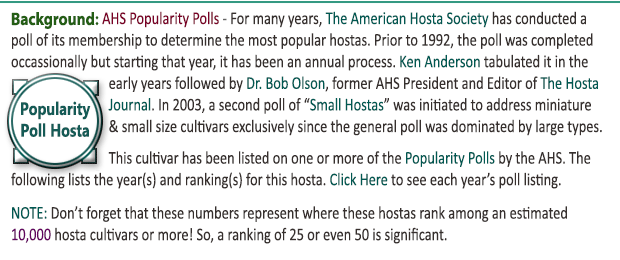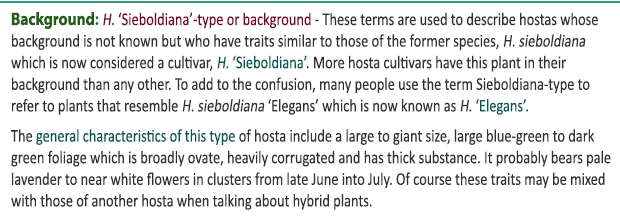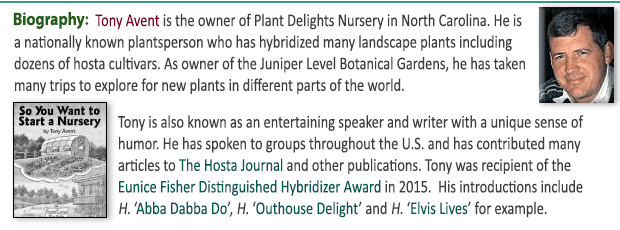|
 This large size (20 inches high
by 42 inches wide) hosta has
broad, light green/yellow to gold colored foliage with leaves
that are moderately corrugated and oblong-ovate
in shape with good substance. Pale lavender, funnel shaped
flowers bloom from mid-July into August. This large size (20 inches high
by 42 inches wide) hosta has
broad, light green/yellow to gold colored foliage with leaves
that are moderately corrugated and oblong-ovate
in shape with good substance. Pale lavender, funnel shaped
flowers bloom from mid-July into August.
Although this cultivar of unidentified parentage has
been
around for a very long time, it was only registered by
Peter Ruh of Ohio in
1996 on behalf of
the originator,
Richard Langfelder who gave a plant
to
Alex
Summers of Delaware in 1964. It may
appear to be in the H. 'Sieboldiana'
form but it has several significant
differences which say it
has other parentage according to
The Hosta Handbook by Mark Zilis (2000).

According to
The Hostapedia by Mark Zilis (2009), this cultivar "...ranks as one of the oldest and
most greatly admired of all gold-leaved hostas. Every collector
recognizes this plant...has been an outstanding source
of both
seedlings and sports. (In many instances, hostas that generate
large numbers of sports do not breed well. Great sport producers
with limited numbers of credited seedlings include 'Gold
Standard', 'Gold
Drop, and 'Blue Angel' )."
The New Encyclopedia of Hostas by
Diana
Grenfell (2009) states: "Although considered a classic, it has never quite
hit the headlines in spite of its many good
qualities, such as its
sun tolerance, but is better
known for its many glamorous sports...Blooms three
weeks later than many yellow-leaved
H. 'Sieboldiana'-types."

"Often called a "Golden Sieboldiana" which it is
not. Mature leaves have only 9 principal veins. The
flowers are similar to those of
H.
sieboldiana, so it is probably a hybrid
between H. 'Fortunei'
and H.
sieboldiana. The leaves appearing in spring
are rugose and greenish yellow after which a flush
of summer leaves appear that are yellow and flat. Of
unknown origin, it was found in
Langfelder's garden,
Chapaqua, N.Y. in 1964. Summers named and registered
it in1969. It has been extensively used for breeding
and is predisposed to mutate to various variegated
forms: dark green center/chartreuse margin = H. 'Abiqua
Moonbeam' and H. 'Mayan Moon'; chartreuse to pale
green center/pale green margin unnamed (referred to
as the "False September Sun"; yellow center/dark
green margin = H. 'September Sun'; yellow
center/white margin = H. 'Lunar Eclipse'; yellow
leaf/white splashes and streaks = H. 'Gosan August
Clouds'; and others."


In an article about hybridizing by
Tony Avent in
The
Hosta Journal (1996 Vol. 27 No. 1), Tony gives the
following comments on cultivars he has introduced: "H. 'Andy Taylor' -
outstanding dark green matte finish hosta with wonderful pure white flowers...An
'August Moon' x H. 'Tardiflora' cross...will never knock your socks off, but
truly wonderful!"

 |
 |
 |
 |
| 8 |
17.3 |
1975 #9
1984 #7
1985 #12 |
1990 #19
1991 #22
1992 #22 |
1993 #23
1996 #24 |
|
|
|
|




 |



